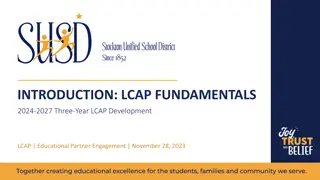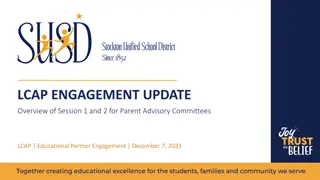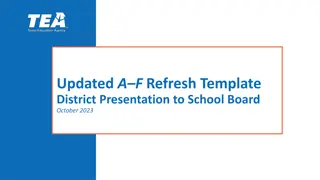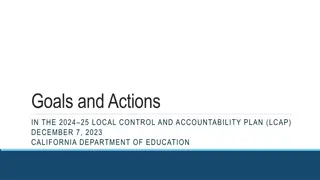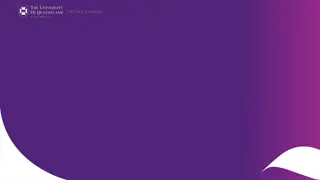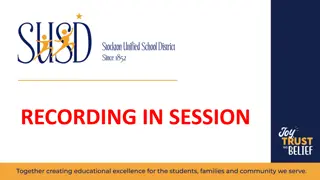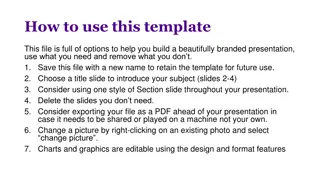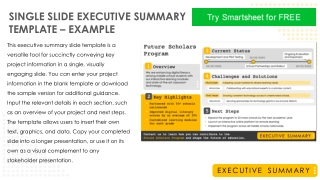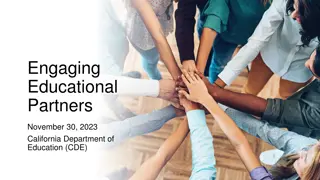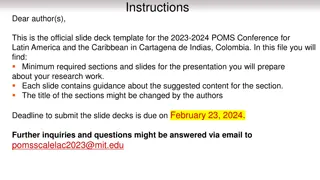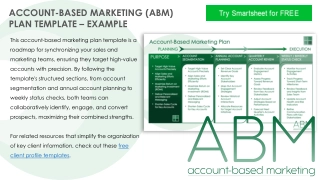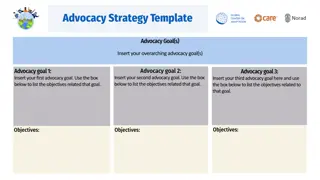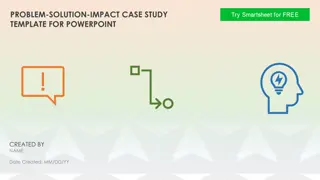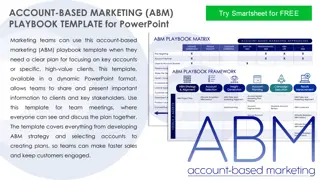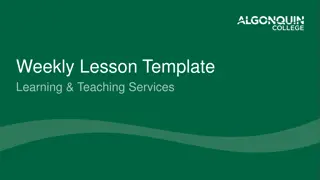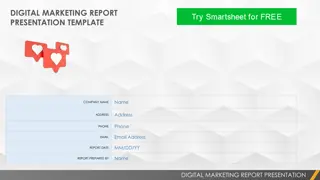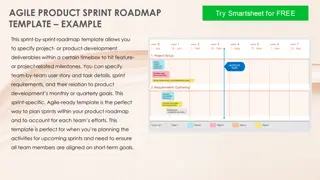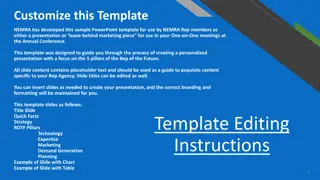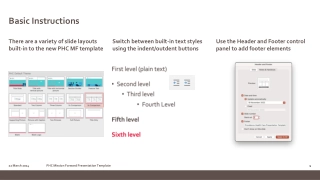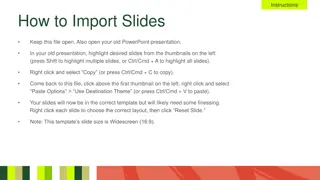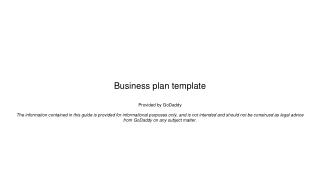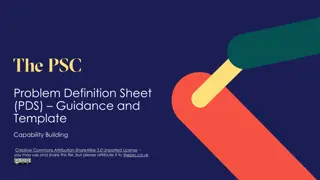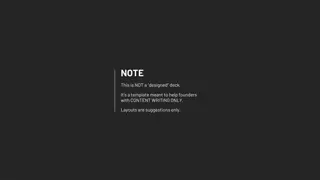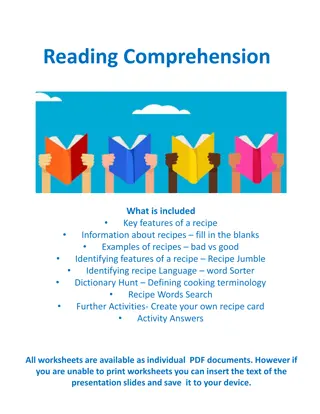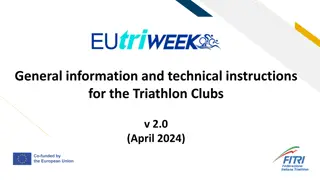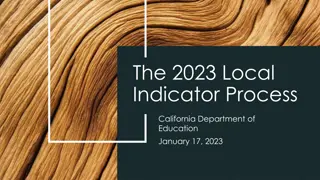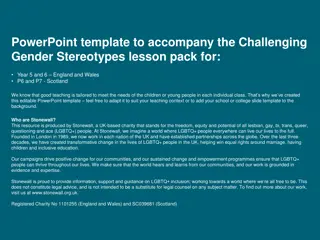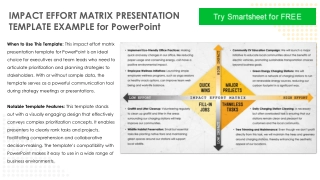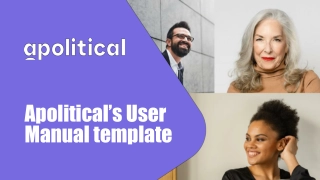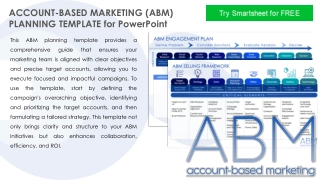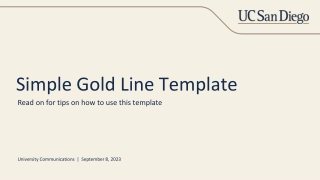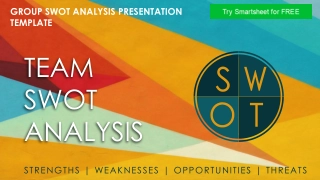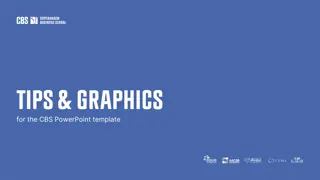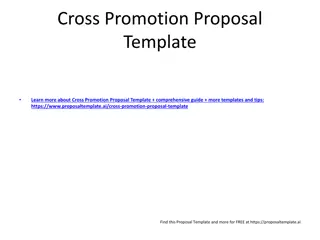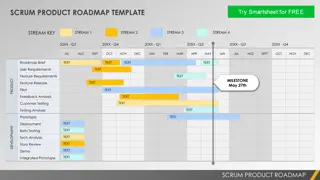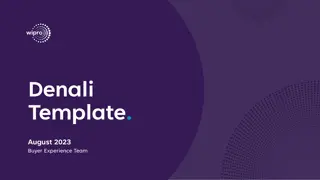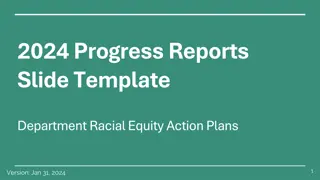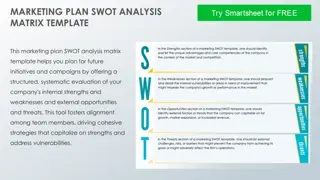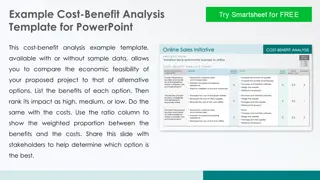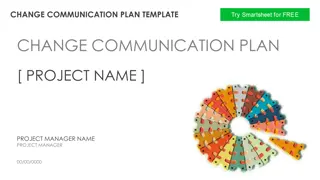Overview of 2024-25 LCAP Template and Instructions
The overview provides details of the 2024-25 Local Control and Accountability Plan (LCAP), including upcoming webinars, template files, and the intended audience. It highlights new elements being introduced and emphasizes the importance of understanding the requirements for the upcoming plan. The presentation targets a wide audience involved in the development and review of the LCAP.
Overview of 2024-25 LCAP Template and Instructions
PowerPoint presentation about 'Overview of 2024-25 LCAP Template and Instructions'. This presentation describes the topic on The overview provides details of the 2024-25 Local Control and Accountability Plan (LCAP), including upcoming webinars, template files, and the intended audience. It highlights new elements being introduced and emphasizes the importance of understanding the requirements for the upcoming plan. The presentation targets a wide audience involved in the development and review of the LCAP.. Download this presentation absolutely free.
Presentation Transcript
Template and Instructions The Template and Instructions for the 2024 25 Local Control and Accountability Plan (LCAP) California Department of Education November 28, 2023
Webinar Series 2 pm, Tuesday, November 28: Template and Instructions 3 pm, Thursday, November 30: Engaging Educational Partners 2 pm, Tuesday, December 5: Goal Analysis 3 pm, Thursday, December 7: Goals and Actions 2 pm, Tuesday, December 12: Required Goals for Equity Multiplier Schools 3 pm, Thursday, December 14: Increased or Improved Services, Part I 2 pm, Tuesday, December 19: Increased or Improved Services, Part II 2 pm, Tuesday, January 9: 2024 Local Indicators 2
Template Files 2023 24 LCAP Annual Update Template: https://www.cde.ca.gov/re/lc/documents/annualupdatetemplate2023.docx 2024 25 LCAP Template: https://www.cde.ca.gov/re/lc/documents/adoptedlcaptemplate2024.docx 2024 25 LCAP Action Tables Template: https://www.cde.ca.gov/re/lc/documents/lcapactiontables2024.xlsx The Budget Overview for Parents Template: https://www.cde.ca.gov/re/lc/documents/budgetoverviewparent.xlsx 3
To provide an overview of the Local Control and Accountability Plan (LCAP) requirements for 2024 25 To provide an overview of the template and instructions for the 2024 25 LCAP. Purpose 4
Note While this presentation will briefly touch on the various components of the LCAP template and instructions, it will spend a majority of the time focusing on the elements that will be implemented for the first time as part of the development of the 2024 25 LCAP. Additional requirements of the instructions will be provided in subsequent webinars. 5
Intended Audience The intended audience for this presentation is anyone who will complete, review, or interact with the 2024 25 LCAP, including: Parents and students Teachers Staff Administrators Advisory committees Members of governing boards or bodies Community members 6 11/28/2023 California Department of Education
Legal Requirement California Education Code (EC) sections 47606.5(e), 52062(a)(6), and 52068(a)(6) require local educational agencies (LEAs) to present a report on the annual update to the LCAP and the Budget Overview for Parents on or before February 28 of each year at a regularly scheduled meeting of the governing board of the LEA. The report must include both of the following: All available midyear outcome data related to metrics identified in the current year s LCAP. All available midyear expenditure and implementation data on all actions identified in the current year s LCAP. 8
Mid-Year Update - Purpose To provide the public with an update on the implementation of the current LCAP and to allow the LEA to be aware of, and plan for, changes that may need to be made based on revised estimates of revenue, budgeted expenditures and/or student performance. 9
Considerations There is no required template for the mid-year update The governing board is not required to adopt the mid-year update The mid-year update will not be included in or attached to, the 2024 25 LCAP; however, the information presented should be used to inform the development of the 2024 25 LCAP 10
Framing the LCAP A tool to set goals and leverage resources to improve student outcome 11
The Local Control and Accountability Plan LEAs are required to develop, adopt, and annually update a three-year LCAP using a template adopted by the California State Board of Education (SBE) The LCAP must include a description of the goals to be achieved for each student group for each state priority and for any local priorities identified by the local governing board or body The LCAP must include an annual review of the effectiveness of the goals and actions from the prior year 12
Requirement to Address the LCFF State Priorities At a minimum, the LCAP must address all Local Control Funding Formula (LCFF) priorities and associated metrics articulated in EC sections 52060(d) and 52066(d), as applicable to the LEA. The LCFF State Priorities Summary provides a summary of EC sections 52060(d) and 52066(d) to aid in the development of the LCAP. 13
Student Groups Ethnic groups (30 or more) Socioeconomically disadvantaged students (30 or more) English learners (30 or more) Long-term English learners (15 or more) New! Students with disabilities (30 or more) Foster youth (15 or more) Homeless youth (15 or more) 14
Functions of the LCAP Development Process The LCAP development process serves three distinct, but related functions: Comprehensive Strategic Planning, particularly to address and reduce disparities in opportunities and outcomes between student groups indicated by the California School Dashboard (Dashboard) Meaningful Engagement of Educational Partners Accountability and Compliance (see notes) 15
Continuous Improvement and Compliance Two sides of the same coin: one is about achieving better results for students and the other is about documenting those results Primary beneficiaries of compliance are the same beneficiaries of our continuous improvement efforts - students Compliance is not about executing a process without deviations (see notes) 16
Sections of the 202425 LCAP Budget Overview For Parents 2023 24 LCAP Annual Update Plan Summary Engaging Educational Partners Goals and Actions Increased or Improved Services for Foster Youth, English Learners, and Low-Income Students Action Tables 17
Reminders The responses to the prompts in the LCAP Template are required to be written in a way that is understandable and accessible to parents. The instructions provide technical information for LEAs to complete the template properly. Instructions have the full force of the law and supersede the prompts. For an LCAP to meet the approval criteria the LEA must adhere to the template and instructions. Instructions are part of the template and must be included when posting the LCAP. 18
Read the Instructions! Important advice for LCAP writers 19
202324 LCAP Annual Update Closing out the 2021 22 through 2023 24 LCAP Cycle 20
To report and review progress made towards the LEAs goals over the past three years To identify the effectiveness or ineffectiveness of the actions in making progress towards the goals To identify the changes that will be made to the LCAP Purpose of the Annual Update 21
Reporting the Year 3 Outcome Goal Goal # Copied from 2023 24 LCAP Copied from 2023 24 LCAP Description Measuring and Reporting Results Desired Outcome for 2023 24 Copied from 2023 24 LCAP Year 1 Outcome Year 2 Outcome Year 3 Outcome Metric Baseline Copied from 2023 24 LCAP Copied from 2023 24 LCAP Copied from 2023 24 LCAP Copied from 2023 24 LCAP [Insert outcome here] 22
Instructions for Reporting the Year 3 Outcome For the Goal Description, Metric, Baseline, Year 1 Outcome, Year 2 Outcome, and Desired Outcome for 2023 24, copy and paste information verbatim from the 2023 24 LCAP. For the Year 3 Outcome, enter the most recent data available. Indicate the school year to which the data applies. 23
Annual UpdateGoal Analysis An analysis of how this goal was carried out in the previous year. 1. A description of any substantive differences in planned actions and actual implementation of these actions. 2. An explanation of material differences between Budgeted Expenditures and Estimated Actual Expenditures and/or Planned Percentages of Improved Services and Estimated Actual Percentages of Improved Services. 3. An explanation of how effective or ineffective the specific actions were in making progress toward the goal during the three-year LCAP cycle. 4. A description of any changes made to the planned goal, metrics, desired outcomes, or actions for the coming year that resulted from reflections on prior practice. (see notes) 24
Instructions for Goal Analysis (1) Instructions for the following prompts are unchanged from the previous LCAP template: 1. A description of any substantive differences in planned actions and actual implementation of these actions. 2. An explanation of material differences between Budgeted Expenditures and Estimated Actual Expenditures and/or Planned Percentages of Improved Services and Estimated Actual Percentages of Improved Services. 25
Instructions for Goal Analysis (2) Highlights of the instructions for prompt 3: 3. An explanation of how effective or ineffective the specific actions were in making progress toward the goal during the three-year LCAP cycle. Describe the effectiveness or ineffectiveness of the specific actions in making progress toward the goal during the three-year LCAP cycle. Effectiveness means the degree to which the actions were successful in producing the desired result and ineffectiveness means that the actions did not produce any significant or desired result. Beginning with the development of the 2024 25 LCAP, the LEA must change actions that have not proven effective over a three- year period. 26
Instructions for Goal Analysis (3) Highlights of the instructions for prompt 4: 4. A description of any changes made to the planned goal, metrics, desired outcomes, or actions for the coming year that resulted from reflections on prior practice. Describe any changes made to this goal, expected outcomes, metrics, or actions to achieve this goal as a result of this analysis For actions that have been identified as ineffective, the LEA must identify the ineffective action and must include a description of the following: The reasons for the ineffectiveness, and How changes to the action will result in a new or strengthened approach. 27
Plan Summary Providing context for the plan 28
Purpose of the Plan Summary A well-developed Plan Summary section provides a meaningful context for the LCAP, providing information about an LEA s community as well as relevant information about student needs and performance. In order to provide a meaningful context for the rest of the LCAP, the content of this section should be clearly and meaningfully related to the content included in the subsequent sections of the LCAP. 29
General Information Reflections: Annual Performance Reflections: Technical Assistance Comprehensive Support and Improvement (CSI) Prompts Components of the Plan Summary 30
This section describes the LEAs students and community. Information about an LEA in terms of geography, enrollment, or employment, the number and size of specific schools, recent community challenges, and other such information as an LEA wishes to include can enable a reader to more fully understand an LEA s LCAP. As part of this response, identify all schools within the LEA receiving Equity Multiplier funding. General Information 31
Reflections: Annual Performance Reflect on the LEA s annual performance on the Dashboard and local data. This may include both successes and challenges identified by the LEA during the development process. As part of this response, the LEA must identify the following, which will remain unchanged during the three-year LCAP cycle: Any school within the LEA that received the lowest performance level on one or more state indicators on the 2023 Dashboard; Any student group within the LEA that received the lowest performance level on one or more state indicators on the 2023 Dashboard; and/or Any student group within a school within the LEA that received the lowest performance level on one or more state indicators on the 2023 Dashboard. 32
Reflections: Technical Assistance Annually identify the reason(s) the LEA is eligible for or has requested technical assistance consistent with EC sections 47607.3, 52071, 52071.5, 52072, or 52072.5, and provide a summary of the work underway as part of receiving technical assistance. LEAs that have requested technical assistance from their county office of education (COE) School districts or COEs that do not have an approvable LCAP by October 8 LEAs eligible for differentiated assistance If the LEA is not eligible for or receiving technical assistance, the LEA may respond to this prompt as Not Applicable. 33
Identify the schools within the LEA that have been identified for CSI Describe how the LEA is supporting the identified schools to develop the CSI plans Describe how the LEA will monitor and evaluate the implementation and effectiveness of the CSI plan to support student and school improvement CSI Summary in LCAP (see notes) 34
Engaging Educational Partners Consulting with educational partners to identify successes and needs 35
Significant and purposeful engagement of parents, students, educators, and other educational partners, including those representing the student groups identified by LCFF, is critical to the development of the LCAP and the budget process. Consistent with statute, comprehensive strategic planning, accountability, and improvement across the state priorities and locally identified priorities should be supported through meaningful engagement of educational partners. Engagement of educational partners is an ongoing, annual process. (see notes) Purpose of the Engaging Educational Partners Section (1 of 2) 36
Purpose of the Engaging Educational Partners Section (2 of 2) This section is designed to reflect how engagement with educational partners influenced the decisions reflected in the adopted LCAP. The goal is to allow educational partners that participated in the LCAP development process, as well as the broader public, to understand how the LEA engaged its educational partners and the impact of that engagement on the plan. LEAs are encouraged to keep this goal in the forefront when completing this section. 37
Summary of the Engagement Process (1) Prompt 1 A summary of the process used to engage educational partners in the development of the LCAP. School districts and county offices of education must, at a minimum, consult with teachers, principals, administrators, other school personnel, local bargaining units, parents, and students in the development of the LCAP. Charter schools must, at a minimum, consult with teachers, principals, administrators, other school personnel, parents, and students in the development of the LCAP. (see notes) 38
Summary of the Engagement Process (2) Prompt 1 (continued) An LEA receiving Equity Multiplier funds must also consult with educational partners at schools generating Equity Multiplier funds in the development of the LCAP, specifically, in the development of the required focus goal for each applicable school. 39
Summary of the Engagement Process (3) Educational Partner(s) Process for Engagement [Identify applicable partner(s) or group(s) here] [Describe the process for engaging the identified educational partner(s) here] 40
Summary of the Engagement Process (4) Instructions Educational Partner(s) Identify the applicable educational partner(s) or group(s) that were engaged in the development of the LCAP. Process for Engagement Describe the engagement process used by the LEA to involve the identified educational partner(s) in the development of the LCAP. At a minimum, the LEA must describe how it met its obligation to consult with all statutorily required educational partners, as applicable to the type of LEA. 41
Summary of the Engagement Process (5) Instructions: Process for Engagement (continued) A sufficient response to this prompt must include general information about the timeline of the process and meetings or other engagement strategies with educational partners. An LEA receiving Equity Multiplier funds must also include a summary of how it consulted with educational partners at schools generating Equity Multiplier funds in the development of the LCAP, specifically, in the development of the required focus goal for each applicable school. 42
How the LCAP Was Influenced By Feedback (1) Prompt 2 A description of how the adopted LCAP was influenced by the feedback provided by educational partners. Instructions: Describe any goals, metrics, actions, or budgeted expenditures in the LCAP that were influenced by or developed in response to the educational partner feedback 43
How the LCAP Was Influenced By Feedback (2) Instructions (continued) A sufficient response to this prompt will provide educational partners and the public with clear, specific information about how the engagement process influenced the development of the LCAP. This may include a description of how the LEA prioritized requests of educational partners within the context of the budgetary resources available or otherwise prioritized areas of focus within the LCAP. An LEA receiving Equity Multiplier funds must include a description of how the consultation with educational partners at schools generating Equity Multiplier funds influenced the development of the adopted LCAP. 44
Goals and Actions Addressing identified needs in support of students 45
Purpose of the Goals and Actions Section The purpose of the Goals and Actions section is two-fold: To identify the goal and why the goal has been identified, how an LEA will know when it has accomplished the goal, what an LEA plans to do to accomplish the goal, and the fiscal resources being used to implement the actions. To communicate to educational partners. 46
Components of the Goals and Actions Section Goal description Type of Goal State Priorities addressed by this goal Explanation of why the LEA has developed this goal Measuring and Reporting Results Goal Analysis Actions Action Tables 47
Description and Why the Goal was Developed Goal Goal # [Goal #] Description [A description of what the LEA plans to accomplish.] Type of Goal [Identify the type of goal here] State Priorities addressed by this goal. [Respond here] An explanation of why the LEA has developed this goal. [Respond here] 48
Goals: New Fields Type of Goal Identify the type of goal being implemented Focus goal Equity multiplier focus goal Broad goal Maintenance of Progress goal State Priorities addressed by this goal Identify each of the state priorities that this goal is intended to address. 49
Considerations When Developing Goals The instructions specify that LEAs must consider performance on the state and local indicators, including their locally collected and reported data for the local indicators that are included in the Dashboard, in determining whether and how to prioritize its goals within the LCAP. LEAs must track progress in all of the LCFF priorities, as applicable to the LEA. The metrics, expected outcomes, and actions included in a goal will be aligned to what the goal intends to achieve. In general, a goal can be focused on the performance of all students, a specific student group(s), narrowing performance gaps, or the implementation of programs and strategies to improve student outcomes. 50


